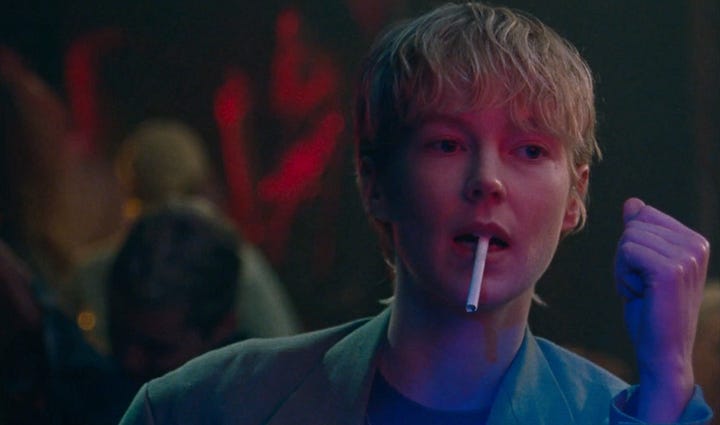Using J-Cuts: BLUE JEAN and DIRK GENTLY'S HOLISTIC DETECTIVE AGENCY
What's a J-Cut, and how is it used for Drama, Comedy, and Exposition
At first glance a queer-80s-personal/political-dilemma-cum-coming-of-age-tale-feature-film and an alternate-universe-surrealist-comedy-detective-book-adaptation-TV-show and wouldn’t seem to have much in common.


And, they don’t.
However, they both often use a particular editing technique.
I’ve been talking a lot about J-cuts lately: on socials, in a webseries I’m directing, on the Draft Zero podcast. Blue Jean and Dirk Gently use J-Cuts to stitch together scenes, but more specifically to narrate events and underscore themes of the whole film/show.
Let’s talk about J-Cuts, baybee!
J-Cut
As Stu summed up (starting 1:42:30), a J-Cut is where “sound starts, and then we cut to the picture which the sound belongs to.”
It’s called J-Cut because of the way the audio/video look on an edit timeline; here’s my approximation of the Blue Jean clip we’re looking at, colour coded for ease:
Put another way: a J-Cut is when Scene 2 audio starts before Scene 2 vision; sometimes Scene 2 audio completely supersedes Scene 1 audio, sometimes the audios are mixed together.
So what effects may that have?
Blue Jean — Drama and Themes
In prior scenes Jean tried to hide her girlfriend Viv from various family members, then Jean and Viv fought over being openly gay or at least acknowledging Viv in other parts of her life.
Here, Jean lights a cigarette and calls Viv to apologise:
Jean gives a stumbling acknowledgement of assholery; to help smooth things over, Viv tells Jean to meet her at a park, hanging up without specifying why.
Jean hangs up and takes another innervating drag off her cigarette, and we hear Viv say “What is it that scares you?” — this is the bottom ‘hook’ of the J-Cut.
After a quick beat, the film cuts to Viv helping Jean put on a helmet as Jean answers “All of it!” in relation to riding a motorcycle.
J-Cutting lets Viv ask “What is it that scares you?” over the image of Jean smoking and thinking, so we consider it in context of Jean’s overall story. The answers flash though our mind — Jean’s scared of being outed, she’s scared of what Viv wants her to commit to, she’s scared of the political and professional climate where her sexuality is being criminalised — in a way they likely wouldn’t if we heard the audio in full context of Viv gearing Jean up for a motorcycle ride.
The question is re-contextualised once the next scene starts, but the J-Cut allows Viv to operate almost as Jean’s internal thoughts and/or conscience, first. It’s simple, direct, and effective.
If your J-Cuts are quite blunt and direct, be aware you don’t over-use them; the audience may tire of things being too spelled out.
You can, however, usually get away with more bluntness in a comedy . . .
Dirk Gently — Comedy and Exposition
When Detectives Estevez and Zimmerfield look into a dead body, they find more questions than answers (and heads).
Zimmerfield asks the coroner “What the hell is [sphyrna mokarran]?” and we hear not-the-coroner’s-voice answer “The great hammerhead shark!”
That voice also has outside wind noises in the audio, so even before the cut to visuals of the next scene, it’s clear something else is going on.
Like Blue Jean, the cut into the next scene doesn’t linger, but comes swiftly.
To help ease the transition, Todd is framed similarly to Zimmerfield:


Todd then replies to this new information “A great hammerhead shark killed Patrick Spring? How is that possible?” before the scene continues on with Dirk giving Todd information about how this could work.
Even more than a straight cut-between-scenes, this puts Todd and Zimmerman clearly in the same boat: perplexedly trying to figure out the surrealist circumstances they’ve stumbled into. In having Dirk explaining to Todd *and* answering Zimmerman, he’s positioned as the one with the most knowledge.
The cut works both to transition us from one scene to the other, and detail for us what all four characters know to this point.
Takeaways and Other Reading
J-Cuts can help ease transitions between scenes, but they can also be funny, expositional, or surprising. J-Cuts can tell us what one or more characters know, directly pose questions, elucidate on the theme of a film, and much more!
We’ve discussed Blue Jean’s colour theory and how it uses mirrors, and took a closer look at how that Dirk Gently scene delivers exposition and character detail alongside its jokes.



